02/18/04 With a few gallons of fuel the engine was started with the prop. It seems to go smoother with time. The bird taxied a bit harsh. The main struts did not seem to give anything and I have the main tires at 60lbs according to another EZ owner advice. Taxied it to the local FBO shop for weighing. At 1425 lb, the bird came in a bit heavier than the factory unit. But I somewhat expected the extra weight due to dual batteries, heavier 6 cyl engine with its bed type mount (tests with Cozy indicate about a 50lb extra weight over a Lyc IO-360), electric adjustable IvoProp, firewall 18 ga steel sheet (15 lb) which factory model does not use, full IFR and other options I put on. Most of extra weight was at the rear (1394 lb RG vs 31 lb NG). For me to fly alone (185lbs) this requires about 40lb of ballast near the nose for aft CG point (the CG shifts forward as fuel tanks empty). With the 155 lb passenger the ballast would not be needed. But it would be a pain to keep playing with ballast. Besides, with only about 31 lbs on NG when parked empty on the ground, the thing would be very tipsy and would have to put the nose down or tie it down. Possibly the simplest thing is to put 40 lb of lead ballast (from scrap yard) in the nose and accept a slightly reduced payload. (early 2005 note: Suceeded in lightening the plane with several changes down to about 1410lbs empty)
The surprise was in total fuel capacity which was 2 gal in the small sump tank, and only about 16.5 gal each main fuel tank - 35 gallons total. This will limit the range to about 700 miles max - or about 550 miles with 45 minutes IFR reserve. The 35 gallons total is less than factory 41 gal specs which may be due to their larger sump tank and possibly different wheel well size. The plus side is that I still have 615 lbs maximum payload available.
Problem: My LS fuel tank is leaking at extreme outboard end. Means I'll
have to tear into it and patch it. Why couldn't it be perfect first time?
And.... the sump tank plastic fuel level sensor switch pipe thread leaked inside...
juck.. carpet... rear seats... mess...
One thing about the bird. It sure is a conversation piece. Different people from around the airport would stop by, admire and ask questions. Everybody loves the looks.
Inspection date:
Talked to nearest FAA FSDO. They said they can do the inspection on
March 15 17. Not bad. The local DAR is in Florida for the winter.
Fixes & More taxi tests:
02/27/04 I got the fuel leaks fixed. Had to cut a hole on top of
the left strake and brush some more sealant goo where I missed. I found a
better pipe joint thread sealant - "TFE Pipe Thread Sealant w/Teflon" - that
claims to be good for all threads (metal, plastic, etc.), fuels, wide range
of temperatures and is available locally at hardware stores.
The sealant did not do much good for the plastic thread (fuel level sensor switch)
and it still kept leaking no matter what goo I put around it. Eventually I got an
aluminum pipe plug which I bored and installed the sensor switch into it with "JB weld".
That worked. I sincerely advise putting a fuel level sensor switch (and light on
panel) to warn you when you have only the few gallons of fuel left in the sump tank.
Hard to hold this bird still on taxi. Just wants to roll.
Have to apply a lot of brake pressure to hold it with prop
going 1000 rpm. At 1500 it seems to let loose even with brakes on
hold. This differential braking steering is something I need to
get used to - over correcting can set the thing into an oscillation.
Had a balmy 60 F today. The cylinders reached up to 160 C uniformly.
But the oil temperature eventually reached 123 C - beyond the recommended
110 C max. Not sure if its really a hi temp oil problem or the way
that the sensor is located and the oil is really not going through cooler.
After stopping, the cowling temperature appeared to be only mild. No
part of the cowling surface was more than warm. 03/15/04 Oil temp problem improved
by replacing the oil regulator plate with a new one.
Installed it 03/28/04. Haven't noticed further leading edge prop damage in subsequent taxi tests. A bit pricey at $60 (+s/h) for 7.5 feet. But cheaper than replacing prop blades.
June 2005 late note: The prop has been plagued by nicks on leading edge. But after about 50 engine hours the nicks problem subsided with just very small debre indication problems. Early in June 2005 I replaced the prop blades with new ones. I took the bird out and started the engine to adjust idling. After pushing it back into the hangar, to my surprise, there were some new small nicks on the prop even though the plane did not move under power. It appears that the small nicks were the result of exhaust particles hitting the prop. Possibly since this was a newly rebuilt engine, there might have been larger particles comming out of the exhaust tubes and hitting the prop. So watch out with a new or rebuilt engine exhaust hitting the prop.
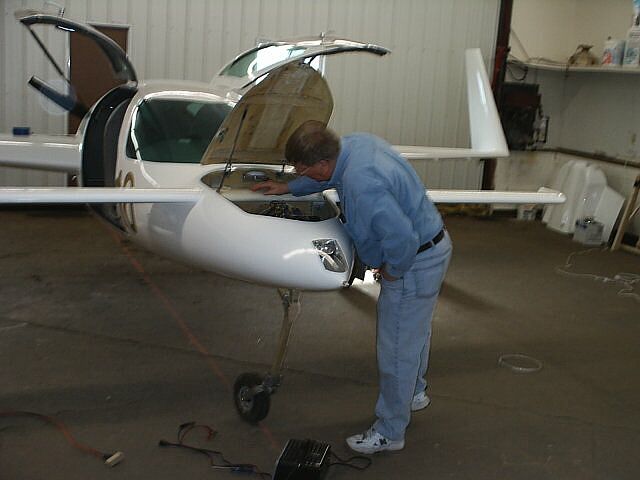 Inspection Day: March 17, 2004.
Inspection Day: March 17, 2004.FAA inspector Gary Soldwisch, hard at work. Inspection completed next morning with some minor regulatory adjustments. Gary was very helpful with suggestions of other phases of aircraft and flight and not just the inspection.
A few things yet to adjust to get plane ready - the poor idling, ordered Prop-Guard leading edge protection to replace the thin stuff that came with the prop.
Contacted Stan at KLS for some flight training they promised. Just my luck... Apparently, recently the factory plane landed in a storm and busted the landing gear, prop and a wing part. Most recent news is they are just waiting for a wood prop they ordered - custom carved.
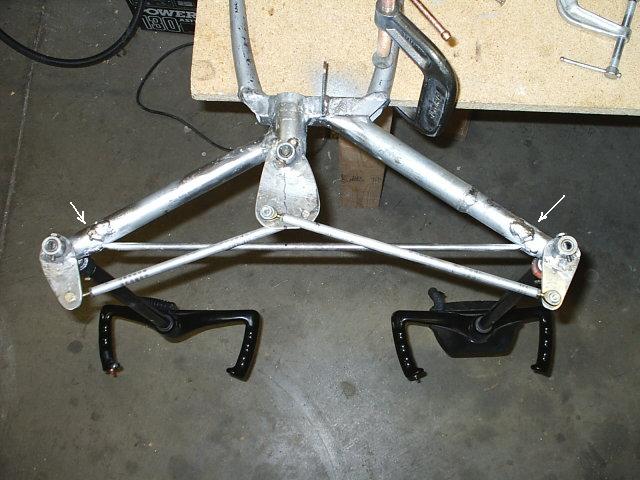 04/02/04 taxi tests: Taxied it to 70mph, three round
trips on the 7/25 6800 x 150 runway. Sure glad for the big runways here. With
SQ2000 being so low, the runway seems so big, I almost was taxiing on one
half of the runway. Getting more used to directional
control. Oil over heating problem - need to make a scoop on bottom to get
more air over the oil cooler. Didn't like the Cessna yoke chain mechanism.
Replaced chain mechanism with rod and bearing arrangement. This resulted
in much more positive aileron control but reduced the yoke turn angle limit
to about 45 degrees - nearly stick control response. Got to get all these
things sorted out before first flight - W & B to go too. News from KLS: they
got their prop and working on exhaust, so will likely get some flight training
soon. Hang on....
04/02/04 taxi tests: Taxied it to 70mph, three round
trips on the 7/25 6800 x 150 runway. Sure glad for the big runways here. With
SQ2000 being so low, the runway seems so big, I almost was taxiing on one
half of the runway. Getting more used to directional
control. Oil over heating problem - need to make a scoop on bottom to get
more air over the oil cooler. Didn't like the Cessna yoke chain mechanism.
Replaced chain mechanism with rod and bearing arrangement. This resulted
in much more positive aileron control but reduced the yoke turn angle limit
to about 45 degrees - nearly stick control response. Got to get all these
things sorted out before first flight - W & B to go too. News from KLS: they
got their prop and working on exhaust, so will likely get some flight training
soon. Hang on....04/12/04 taxi tests: Installed a scoop on bottom right strake to divert more air to oil cooler. Taxied to 80mph. Oil stayed at about 90C (194F) which is good - OAT was 10C. However when stopped taxiing during idle, the oil temperature climbed quickly to 100C. There is no fan action to cool it down when idling & not moving. I Installed a small 12VDC control fan to switch on for long standing/idling. The oil cooler is independent. i.e. has own exit and does not feed hot air to engine compartment like some other canards. The cylinders stayed at about 130C indicative of sufficient cooling capacity from the side scoops. Max limit for cylinders is 250C for the plug type CHT sensors.
4/22/04: 4/27/04: 05/03/04 Talked to KLS. They fixed their bird.
I plan to be there Thursday for flight training. I've been making some mods in the
meantime and will need to finish those and then do first flight..... We're getting
there....
Yes... Got flight training May 6/7 at KLS, about 4 hrs, mostly takeoff and landings. Glad I did it. It is quite different from handling a standard configuration aircraft. I think I can takeoff and land it fairly safely although may not look as good as Stan Montgomery doing it. I'll get there with practice... Now just a few more mods I am doing and W&B and good weather and .....
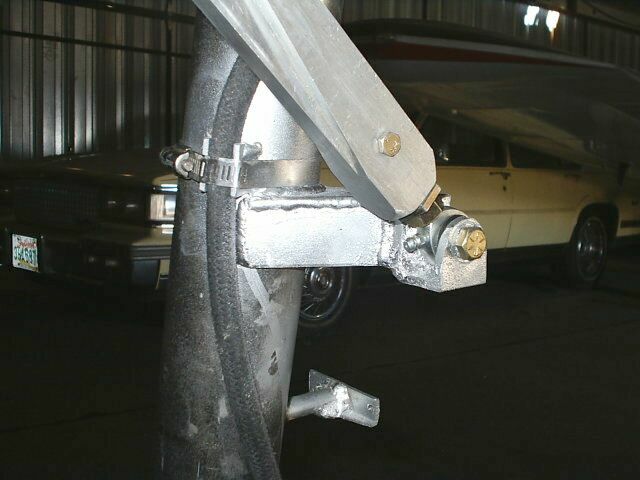 05/26/04 I am still fussing with some details here. KLS suggested that
I reinforce the gear brace lower pivot pin - as a result of their
landing gear busting. I went a little further and decided to eliminate
the free play that was in the factory design. I converted the pivot using a high
strength rod end bearing (Aurora XAM-6Z with a 17,500 lbs tensile load
rating). The rod threads into a bolt (5/8 x 1.75 NC), which I threaded and cut the
head size down, and the bolt threads into the aluminum lower brace. I also welded the outer reinforcement bracket
as per factory mod. A modified RG cylinder yet to be installed and then W&B,
and hope first flight soon. The different parts slow delivery, doing things
several times until right, and I have to run my business too, keeps delaying things.
But hang on......
05/26/04 I am still fussing with some details here. KLS suggested that
I reinforce the gear brace lower pivot pin - as a result of their
landing gear busting. I went a little further and decided to eliminate
the free play that was in the factory design. I converted the pivot using a high
strength rod end bearing (Aurora XAM-6Z with a 17,500 lbs tensile load
rating). The rod threads into a bolt (5/8 x 1.75 NC), which I threaded and cut the
head size down, and the bolt threads into the aluminum lower brace. I also welded the outer reinforcement bracket
as per factory mod. A modified RG cylinder yet to be installed and then W&B,
and hope first flight soon. The different parts slow delivery, doing things
several times until right, and I have to run my business too, keeps delaying things.
But hang on......05/27/04: On taxi tests the brake pressure required for stopping was unacceptable. It may have been due to not so ideal position when mounting my pedal assembly. After consulting Matco, they indicated that it probably needs a higher mechanical advantage. I took the pedal assembly out and lowered (re-welded) the brake actuator slots on the pedal stems down by about 1.25". That changed the mechanical advantage ratio from about 1.7 to about 2.1 - much closer to ideal 2.5.
05/31/04: I finished the RG changes I wanted - replaced the factory brass actuators (1.5 dia) with smaller diameter (1.25 dia) steel actuators and increased the pressure for up-stroke (and boy do the RG ever come up fast - 3 seconds flat), decreased the pressure for down-stroke; mounted stop blocks against end of RG actuators so that in top position the braces are relieved of stress.
Note: The factory (brass) actuators have a lower pressure limit (about 1000 PSI) whereas the steel actuators can go up to 5000 PSI. So I can safely increase the pressure to 1500 psi and speed up the gear retraction process with the smaller diameter actuator cylinders. The added benefit is about 5 lbs of weight savings since the steel units are smaller than the brass units.
All the mods I needed done before first flight are finished. Only need W&B and wait for good weather.

|
Below is a short video of first flight. Right click on rectangle and click on "Play" |
Yessiree. It lasted about 25 minutes. I landed without problems inspite of a fair cross wind. I went about 120kts max and did not retract the gear. There are some problems to tweak out. The oil is still near max temperature in flight. Probably need a bigger oil cooler. The alternator quit working half way into the flight. The engine was throwing out a little oil - I had it up to 7 quarts, maybe too much. The radio did not work once I got off the ground and caused some confusion with other planes that could not contact me. But I had the local airport fire/rescue standing by and they did some communication for me.
Both the takeoff and landing went fine. I landed only once and it settled on the ground right away with no bounce. Glad I had the factory training.
The IVO prop worked fine for the short operating range. At takeoff it had real good punch (or maybe it was the combo of 200+HP engine, electronic ignition...). And when I reached about 110 kts I had to increase the pitch to keep it from over revving. The adjustment was smooth and short meaning it had plenty of pitch left for higher speeds.
The Dynon EFIS-D10 worked well too - agreed with the backup horizon, speed and altitude meters.
Will keep you posted with more flight test results. But will have to fix the oil temp, radio, and check oil leak problems. Parts take forever to order/arrive and then installing them... so hang on...
07/08/04 Yes. I am still around... The oil cooler modification in the cowling is taking the longest. There are a number of parts to fabricate all over again: a new larger lower scoop, a new mounting for the cooler with lower and upper ducts, a new more powerful fan to blow through the cooler when taxiing, and a new reverse top scoop, repainting the parts, etc. Fiberglassing when building is more progressive since you can do large sections on different parts of the plane. Doing a smaller setup takes forever between different layers curing at 12 hours each. But most of it is done now and hope to fly the thing again next week at the latest. Most other problems have been sorted out (I hope) - except for an oil leak in the oil pan which originally had a big shaft hole which I welded shut but is leaking somewhat and got to take it out and seal up the leak cracks (JB Weld?). I am waiting for a new oil pan gasket - got one but it came broken in the mail; and for more epoxy - ran out today.
07/11/04 - Lousy luck. Trying to get the oil pan out today found that one bolt
cannot be removed without removing a lot more from engine parts out of way
and either raising the engine or sliding it forward to get at the %#@* bolt.
Forget Oshkosh 2004. But most of the rest mods are done. Well thats the name of
the game. Just wish I had little more luck in the "finishing" process.
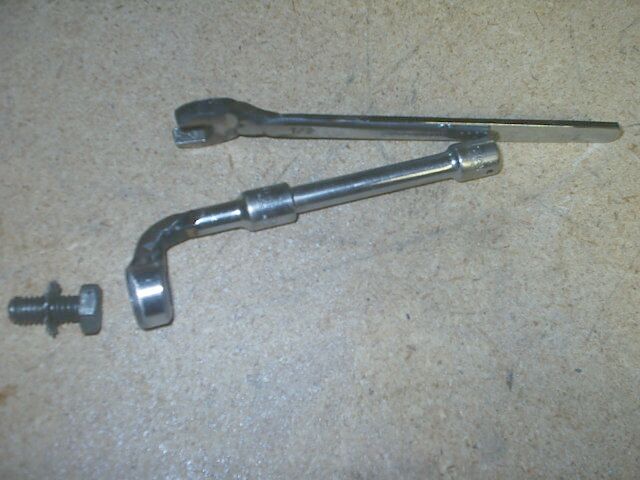 07/28/04 - Lost about two weeks after a minor bladder surgery - the
resulting complication/pain kept me mostly at home and horizontal. But I am
getting more around lately and today I finished the mods.
I managed to remove oil pan without shifting engine by fabricating special
offset small socket and wrench to get into the tight
spaces.
07/28/04 - Lost about two weeks after a minor bladder surgery - the
resulting complication/pain kept me mostly at home and horizontal. But I am
getting more around lately and today I finished the mods.
I managed to remove oil pan without shifting engine by fabricating special
offset small socket and wrench to get into the tight
spaces.
Winds were mild and temperature was about 70F. It appears the mods worked. Radio worked right through, both CHT and oil temperatures stayed within limits. The oil temp stayed between 95 and 104 C and it cooled down after landing. The new alternator worked fine all the way.
Takeoff: This time I flew at aft CG limit and the plane was very sensitive to pitch in flight. It took off with a high nose attitude.
Flying: Again, the plane was very pitch sensitive, hard to keep it exactly level - should have added more balast in the nose. I flew a little too slow - about 100kts.
Landing: My landing was not as nice as first time - a little bumpy - and I did not watch my speeds as well. I aimed to touch down at 80kts but it kept floating and I touched down at about 60kts near stall speed, but it kept good aileron control anyway. When I pushed the nose down it started shimming. Got to check the NG mounting.
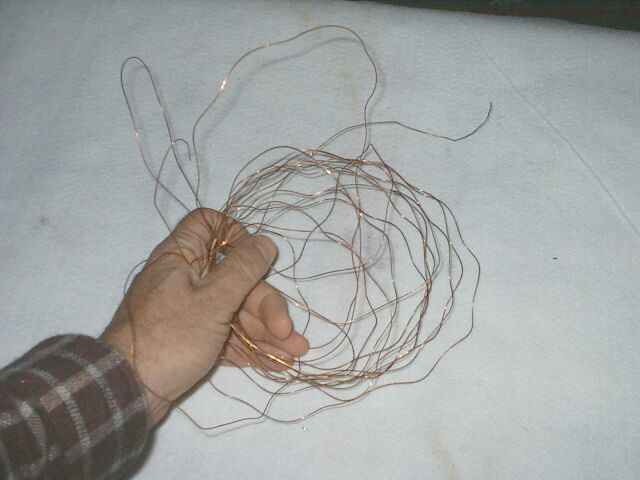 08/04/04: Third flight
08/04/04: Third flightThis one didn't go right. The engine vibrated a lot and the plane rolled hard to the right and the temperatures were high inspite of only 65F OAT. The plane was harder to control with sharp left aileron needed to keep it level. After landing I found a 25 foot wire wrapped around the propeller. It came out of the SCAT oil breather tubing that was pointing out of the airflow cowling exit. That probably caused the vibration and the extra prop torque to the right and possibly the harder working engine generated extra heat. Will have to check for prop damage. Amazing how one ounce of wire can cause so much problems. On the plus side, I had more front ballast this time and the pitch control improved a lot.
08/13/04: Fourth flight
This time everything seemed to go well with the engine. OAT was about 70F.
The CHT never went over 180C (360F) and oil temp maxed out at 105C (221F),
below its 111C limit. I stayed below 140kts and did not retract the gear.
I have noticed the bird has a slight roll tendency to the right
and needs constant aileron correction.
The only other catch was the wind, rather gusty with about 7kts
cross wind. Went around the first time I tried to land and second time it
bounced once. Maybe should have waited for calmer winds. Probably really need
more flying time to nail the landing skills a little more.
Fortunately the wide RG stance is forgiving - would be hard to tip this thing
over once you hit the ground.
I fixed the engine breather tubing problem by permanently glassing a piece of aluminum tubing onto the cowling exhaust port, the tube points outside and reaches inside toward the engine, the SCAT tubing is clamped to the aluminum tube. So there is no likely way that it would come out of the engine.
There is one characteristic about the SQ2000 with RG. With the RG down the RG acts like a air brake and you can descend fairly steeply down to the runway - probably a 1:7 glide ratio equivalent to an Archer with half flaps on. The open wheel wells probably also add to the braking effect - like two small parachutes when going slower at high angle of attack. But when it slows down to about 80kts the bird can glide near ground for longer and you have to ease it down with elevator control.
Fifth flight - same day
Near 8pm the winds became steady and the turbulence went away. I took the bird
out for another half hour to practice landings - did about four more.
08/17/04: Sixth flight
Took it out in the morning with calm winds - OAT about 64F. Made four landings.
Prior to this flight I adjusted the nose gear so the nose stands higher. That
seems to prevent the occasional NG wheel shimmy and bottoming out effect I had
problems with on prior flight landings.
This time I tested the wheel retracts getting about 1800ft/min climb rate
and had it up to 160kts IAS but did not go too far from the airport.
There is a lot more to do before I test upper speeds including closing different
gaps in the wings (wing bolt holes), filling in the joint fairings, and putting
on the wheel covers. For now I am leaving the wheel covers off until I become more
familiar with the aircraft in case the wheel covers affect handling characteristics
in the RG down position.
CHT's were fine - staying below 360F. But the oil temp would max out
after a couple of takeoff's and would come down on descents. There still appears
to be a small oil leak somewhere I got to chase down....
BTW the vents I made
drawing air from front wheel well appear to work. I might remove the top
rear fresh air scoop and put a fan in the wheel went to get air when taxiing
and remove the air drag from the extra scoop. The rear fan would only be
for warm air for winter heating.
08/19/04: Seventh flight
Took it out this AM with 50F OAT. Needless to say the oil temperature
stayed fine within limits. This time I was more relaxed getting familiar
with the bird. With the left tank full and right near empty it had a slight
roll to right and no roll when the engine was idling, meaning that the
prop torque contributes to the roll tendency. Will try to adjust for the
roll by adding extra washer to right wing top bolt to tilt it up a little.
This time I roughly tested gliding down at 105KTS and got about 550ft/min descent. That is about a 19:1 glide ratio.
I would put in more test flight hours if the re-construction was finished on the 13/31 runway which has the predominant winds. The currently available 7/25 runway has suitable winds only a few times a week or some mornings or evenings when winds are calm anyway.
08/30/04: Would have flown sooner but had to wait for some small parts that took the "slow boat to china".
09/01/04: Eighth flight
Early moring flight went smooth. Mainly wanted to test the wing tilt adjustment.
The adjustment worked great, the roll tendency gone. The oil temp went high at 3500ft. But there was
a temperature inversion - on the ground (1700ft) OAT was 61F but at 3500ft it was 82F.
Experimented with rudders near 110kts. Amazing effect. You hit the right rudder and the plane rolls/banks instantly to the right just as if you used ailerons. You could probably roll the plane over using rudders - or make fast turns using rudders - "look Ma no hands". At slow speed near ground the rudders seem to act in more normal (conventional aircraft) fashion. Soooo... in flight, leave the rudders alone - or if ailerons fail, you can use the rudders instead.... talking about redundancy...
09/12/04: Still around... Making more adjustments ... parts take long time... Just installed the third bigger oil cooler (SW 10614R, almost 2" wider). Have to change control cables - my inexpensive cables with simple piano wire were binding and the throttle cable end mounting worked lose during a ground test (luckily). Also I need to put a heavier ground and 12V side cables for the main battery.
09/26/04: Ninth flight After finally finishing the adjustments: New larger oil cooler, new type A920 carb related control cables and heftier ground and battery cables leading to the front I got it up again. This time was an hour flight with 82F near ground (1700ft) and about 52F at 9000ft. Everything seemed to go fine - except my landing, while OK, was still not a greaser. The new (large SW10614R) oil cooler kept the oil temperature well below max at all times. The highest it went was 104C (111C allowed) in continuous climb. Took it up to about 9500ft. Tried canard stalls. The front stalls near 66 knots, with slight buffeting noticable. Keeping the elevators max down the bird would simply descend about 800fpm. At less elevator pressure it would do a 10 second bobbing sequence. Tried leaning the engine at cruise and got about 8gph at 140kts. Also tried some steep turns and descents and climbs. I think I need to find more optimum ignition advance settings, this time it would not quite climb as fast (about 1500fmp) and lower high speed performance.
Just had a recent email from Bob, an A&P, informing me that about all aircraft engines have an oil overheating problem during breakin period. With only 9 hours on my rebuilt, now I wonder if a larger oil cooler was needed. However, that means that it should be at least adequate in hot climates.
09/29/04: Tenth flight Went up late afternoon after winds calmed down - took it up to 6500ft and about 165kts IAS. The GPS read about 5kts more on average than IAS - as well as the altitude. At about 70F OAT the OT stayed cool and CHT was fine at cruise but C3&4 went near limit on climbs.
The problem this time was the alternator quit about 30 minutes into the flight and I had to come down a little sooner than planed. I got one of those Denso 45A mini lightweight alternators I purchased from a supplier. It quit after I put more load on it (strobes, etc) - but the ammeter indicated no more than about 28A. Don't know if it was over-rated or if it is too hot under the cowling for it - I think it is a CW but its turning CCW from the engine. Anybody has knowledge/suggestions?
10/03/04: 11th flight (6.2hrs) Winds predicted to be higher than desired today. But in the morning the winds were about 10kts and lined up with runway. After half hour the winds picked up a lot and I landed. Otherwise everything went OK. I used a spare small alternator which is ok for small daytime loads until I get the bigger one I ordered.
10/04/04: 12th flight (7.1hrs) Took it up mainly to calibrate the EFIS-D10 magnetometer. The procedure takes about half hour. Looks like I will have to try again - don't think I got it right. Otherwise things went OK and even managed a nice touchdown in 10kts cross wind with gusts. Now waiting for the larger replacement alternator from Vans. But the spare small alternator was OK for the small load.
There is a general problem with the nose wheel throwing stuff back on the prop. I have thin chrome tape prop guard edging from IvoProp and I cover that with the plastic "PropGuard" stuff. Because of this problem I generally don't practice landings. I am trying to get a smooth nose tire which would less likely trap pebbles and throw it on the prop.
I tried several canard stalls and with about mid CG the thing stalls at about 66kts where it is supposed to.
10/05/04: 13th flight (8.3hrs) Went up later in day when winds calmed down and flew around till sunset. Everything went fine - oil temperature was fine at all times. This time I generally was just building time, getting more familiar with the bird and watching for any anomalies. No problems were observed. At 5K+ altitude the IAS is usually about 10-15kts lower than GPS. Had it up to 165kt IAS. I did try the Digitrak autopilot which seems to work fine following the GPS course. Wish I had the altitude hold too. Still waiting for larger alternator to use with night time equipment.
10/07/04: 14th flight (9.7hrs) Spent time yesterday and part of today installing the larger alternator. Took it up today to check the alternator and put more flight time in. Weather was real nice for flying. The new alternator handled all the loads nicely and kept the voltage to 14V+. After about 1.25 hrs I thought I smelled some fuel inside the cabin. Went down and checked but could not find anything out of normal - there are fuel lines and electric fuel pumps behind rear seats. Oil temperature again no problem. Spent time cruising around nearby towns. Yesterday noticed a hairline crack seeping fuel very slowly at the upper patch on left tank where I repaired it. Will have to empty tank and patch it.
10/08/04: 15th flight (12.0hrs) Putting time in toward the 40 hour test period. Did some maneuvers, steep turns, etc. Kept it at leasurely 120kts - cheapest GPH. Keeping the bird level is little different from standard tractors. Fairly sensitive to pitch. One way to keep it level in pitch is to set it approximately correct. The bird then would go through + or - 100 ft altitude cycles: if it went down the speed would pick up a bit and the canard would have more lift, if it went up the loss of speed would have less canard lift and it would come down again.
Oh yes, the overhead heater really works. It got a little cool at 5500ft and I tried the heater. It worked great but came from overhead behind me to warm the cabin. The problem were my feet which were cool in the sandals. The heater works fine even without the fan which I built in - apparently the pressure built up in the cowling from the cooling scoops pushes the air into the cabin too. So there is an effective cabin heat solution no need for an oil cooler heater as in Velocities, etc. You can see some details of heater/cooler setup at in the engine heat muff discussion and some comments about the overhead fan in the interior discussion.
10/10/04: 16th flight (13.1hrs total) Things went OK. Went up to about 180kts. At higher speeds the elevator control becomes very stiff - harder to control the pitch - the elevator seems to need higher forces at those speeds. Went down after about an hour to get fuel and found a real bad nick on the prop - one screw was missing from the cowling, got to be more careful. I planned more flying but the prop damage stopped it for the day - had to epoxy the damage and it takes curing time. Took my camera for some flight shots but forgot all about it. Did a better landing this time and tried to make it short. I probably had it stopped in less than 3000 feet.
10/11/04: 17th flight (15.2hrs total)
Working my test hours off.
Took some pictures this time. Just click on each to enlarge. From left to right:
1. the subdivision where we live 2. The great Missouri river 3. one of the
typical SD towns near by. 4. typical SD sunset.
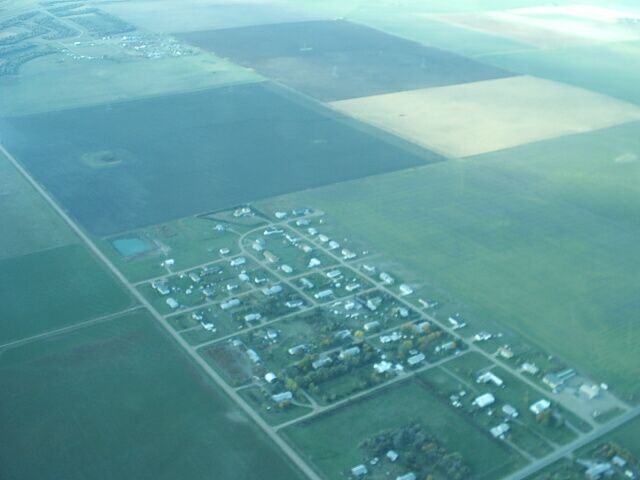
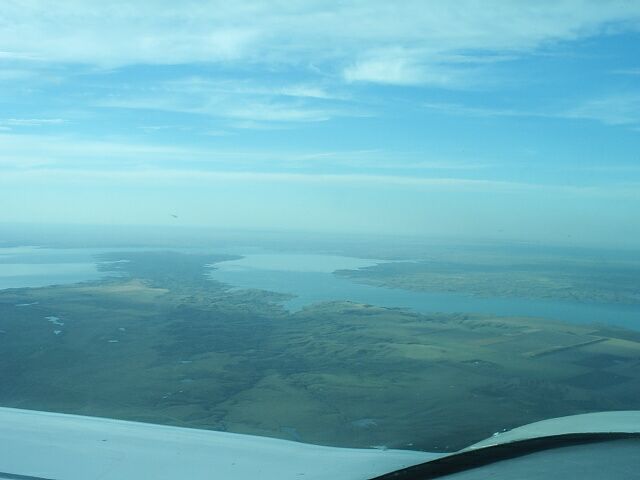
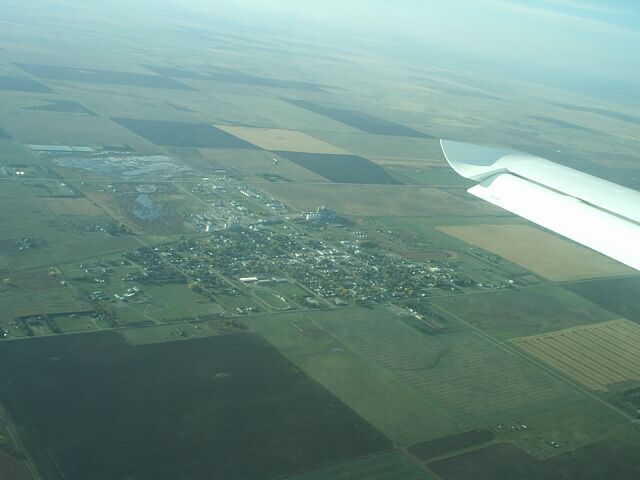
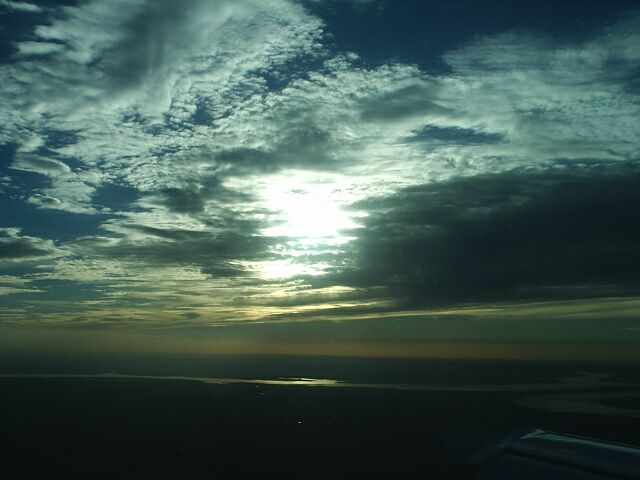
10/11/04: 18th flight (18.1hrs total)
Took it out about 60mi north to some towns. Tested it at about
8500ft and got about 200kts on the GPS. But thats tops so far.
The IAS and GPS speeds are really different at higher speeds and
altitudes. At 8500ft a 150kts IAS would show up about 180kts GPS.
The one surprising thing about the Franklin engine is its fuel
economy. With leaning at about 125kts it would be using about 5gal/hr.
Even though the Franklin is on the heavy side, it is turning out fairly
good with excellent compression and apparent reliability.
The Digitrak autopilot works fine in conjunction with the GoTo GPS
setting and tracks the GPS preset course line right to the destination.
The autopilot is real nice for turbulence.
Also tried the Narco-122D VOR which seems to work fine - haven't tried its
glide slope function yet nor the GPS IFR approach.
Glad things seem to be wired correctly.
Went up again in the afternoon to put some time in but after I got up, the wind picked up a lot. I went back down and landed in what must have been 40kts cross wind. The plane was pointing about 30 degrees to right of runway while following the center line at 80kts. Never seen anything like it. I came down hard but managed to taxi back to hangar. But the left gear did not look vertical with the lower left pivot bracket looking out of shape.
10/18/04: I fixed the pivot bracket. But when putting things back together I noticed a hair line crack in the aluminum weld on the trunion plate collar around the trunion pin. With that needing fixing and a number of other mods needed and SD weather turning colder now, I plan to tow it back to my heated garage. So there may be no flight reports for a while.
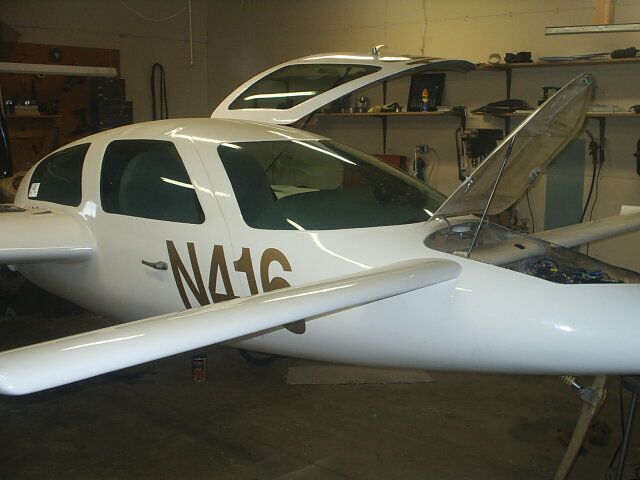 10/24/04: Back in the heated garage. Much nicer to work in here than the drafty
open T hangar (with a leaky roof). Got a list of about 20 various adjustments
to do from flight test observations.
10/24/04: Back in the heated garage. Much nicer to work in here than the drafty
open T hangar (with a leaky roof). Got a list of about 20 various adjustments
to do from flight test observations.
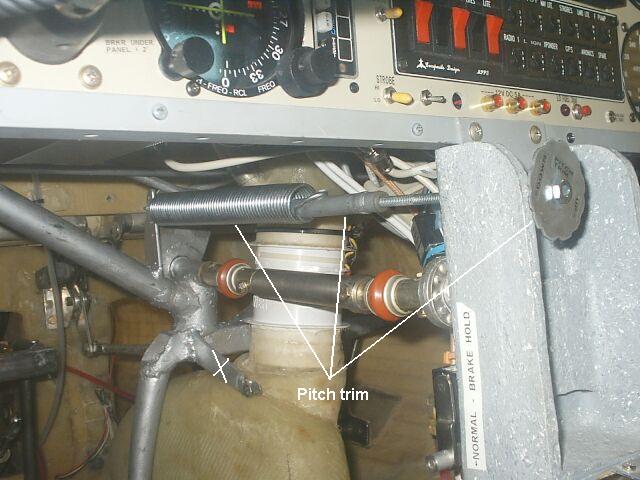 11/12/04: (Still in garage)
Trim control revision. I had bad luck with purchased trim systems.
Originally I installed Ran's trim control - typical wheel type - with plastic
gears which proved
to not be sturdy enough in flight because of the extra forces required with
canard elevator. The second effort was Strong's pitch trim for canards but
which did not fit with the yoke assembly.
11/12/04: (Still in garage)
Trim control revision. I had bad luck with purchased trim systems.
Originally I installed Ran's trim control - typical wheel type - with plastic
gears which proved
to not be sturdy enough in flight because of the extra forces required with
canard elevator. The second effort was Strong's pitch trim for canards but
which did not fit with the yoke assembly.The left photo shows my $15 pitch trim solution - a spring with a screw jack for the threaded rod with a slightly re-shaped 2" fender washer as an adjusting knob. Not seen is a locknut about 3" on the threaded rod in front of the washer that is held against a metal plate on the lower console front vertical part. With a little bit of grease the system seems to work fine.
12/07/04: Still in the garage. Fussing with any adjustments and refinements I can find. Weather averaging about 20F is not the ideal for flying anyway.
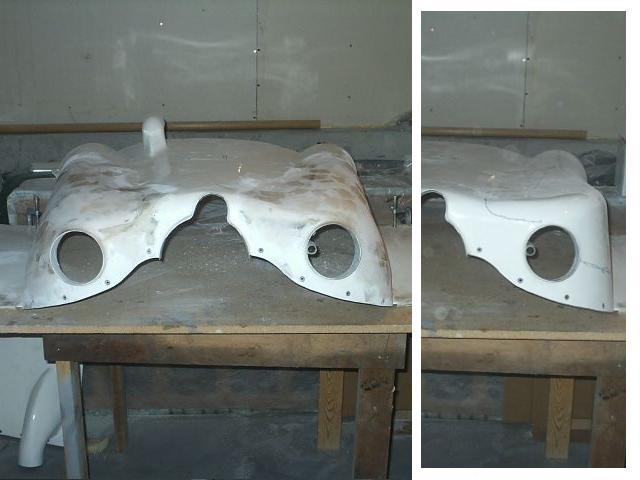 01/21/05 Re-shaping the cowling. The rear top part of the original cowling
I made stuck out more then necessary. So I am using the remaining cold
weather time to re-shape it. The photo shows the process of nearly finished shaping
and sanding. The right side shows the old right corner stuck out. Essentially
I just have the cowling sanding/filling and painting to do and the bird is
ready to go again with all the mods. And the cold weather is showing
signs of breaking. Had an occasional day as high as 50F. Hope to be flying
soon.
01/21/05 Re-shaping the cowling. The rear top part of the original cowling
I made stuck out more then necessary. So I am using the remaining cold
weather time to re-shape it. The photo shows the process of nearly finished shaping
and sanding. The right side shows the old right corner stuck out. Essentially
I just have the cowling sanding/filling and painting to do and the bird is
ready to go again with all the mods. And the cold weather is showing
signs of breaking. Had an occasional day as high as 50F. Hope to be flying
soon.
This is the first flight this year after hauling the bird from garage to the airport. Everything went smooth. Had a nice balmy 65F day. Cylinder and oil temps stayed well below limits - even in the long climb. Took it out in the afternoon, spending the morning putting the wings back on and doing W & B after all those mods I did during the cold weather. The surprise was the reduction in overall weight, from 1419 down to about 1380. I did several things trying to reduce the weight: exchanged the aluminum intake manifolds for lightweight magnesium ones, replaced the heavier brass actuators with smaller steel ones, replaced the vacuum horizon gyro system (pump, etc.) with an electric unit, several other places mods where I could save weight and the reshaping of the cowling might have saved a little. That now gives me a 656lb payload. There may be some error in the results since I used the cheaper lever type weigh scale system I purchased from Spruce.
02/11/05: 20th flight (22.4hrs total)
Had a nice 55F day across SD.
This time I went "cross country" within my 75nm allowed radius: from Pierre to
Chamberlain, to Mobridge to Philip and back to Pierre SD. Landed at all
airports. Somewhat shorter runways, 4000ft+, for the other three airports.
Everything went well. 3+ hours of flying welcomes a rest at end. I am feeling
bit of engine vibrations through the cabin. Find that about 2400rpm minimizes it.
Not sure if its the engine or prop or I am too fussy.
02/13/05: 21st flight (24.5hrs total)
Went up to buzz around to put time in. About 50F on ground but about 36F
at altitude. Could have stayed longer but my feet were getting chilly.
Otherwise everything went fine.
The cool air seems to makes the bird go faster.
At about 2400rpm and less than half throttle it was doing 160kts.
Did some stall tests with turns. At stall the turns feel a little mushy but
controllable.
02/17/05: 22nd flight (26.3hrs total)
About 45F on ground OAT but cooler higher.
The winds were calm when I went up but picked up when I saw some clouds
rolling in. So I landed to avoid possible bad weather. Everything went fine
- almost. The 15kts winds were lined up with runway 31 but I went down on
25 and was wondering why the bird was pointing so much to the right. Had a bit
of a bouncy landing with the 12kts cross wind. But before coming down I pulled
a negative g. I was adjusting heater and other things before landing and must
have pulled the yoke hard back ( or maybe it was a gust) and the bird went sharply
up. But then of course the yoke pushes against me and the thing went sharply down
- so much so that loose things around me went up about a foot. The bird is fairly
pitch control sensitive so the thing to do is to relax the grip on the yoke and
recover slowly. After landing I noticed that some of the paint and filling around
the canard/fuselage joint loosened up - but I seen that on the factory model too.
Since on the topic on pitch control, I find flying the bird several hours requires a lot of altitude concentration. It would not be very comfortable on a long trip to mind the altitude all the time. So I bit the bullet and ordered ALTRAK auto pitch control a few days ago.
02/18/05: 23nd flight (28.4hrs total)
Went up passing time tracing various
county roads I drive in the car. Was sunny 42F on ground. A bit choppy at about 2000
AGL - probably smoother air up higher but kind of cold up there. Otherwise things
went fine. Was doing a leisurely 120kts and about 5gal/hr. The name of
the game now is cheap hours and not speed. 11.6 hours to go test phase.
I think this bird has a different way of building speed toward the top end compared to conventional aircraft I have flown - which assume farly constant AOA at most speeds. It seems the SQ2000 varies attitude (or angle of attack, AOA) with speed more than conventional aircraft and needs to work its way to a lower AOA at higher speeds. This building up of speed and gradual change in AOA requires more power while maintaining constant altitude. The easiest way to build up speed is to climb a little higher and then dive down to the desired speed and level off. Otherwise it will require "plowing" from low speed higher AOA to desired higher speed lower AOA - somewhat similar to recovering from slow flight.
The other factor that adds to the same phenomenom is the canard elevator. At lower speeds (90kts) it is about 20 degrees, like flaps producing drag. It changes its angle proportional to speed eventualy reaching near horizontal at high speeds where it has least drag.
02/18/05:
Didn't fly it for over a week. Had a leaky brake line and waited for replacement tubing.
02/27/05:
Got the brake line part and replaced the line and bled both sides. Took most of
the afternoon. I also took off the prop and (03/01/05) tried to balance it
to get rid of the, not so major, but somewhat annoying vibration -but
without much success. Purchased a new set of blades from IVO. Hope to get things back
and fly soon. I also may be the proud owner of the next door vacant hangar
soon. See the hangar page.
03/03/05: 24th flight (30.9 hrs total)
Nice day so I managed to put together everything back and took it up.
Everything went smooth. I purchased a very sensitive carbon monoxide meter
($250) that gives almost instantenous readings. I turned the heater on
and in about 20 seconds the meter read about 30ppm. Would have gone higher
but I closed off the heat. The little $5 card yellow spot indicator
purchased from Spruce etc. didn't do a thing. I suppose it would get dark
eventually - maybe after you are already dead. The other thing I noticed is
that when going over 170 KIAS the left aileron seems to flutter. Got to check
with the factory about that. (9.1 test hours to go.)
One advantage of having your own bird is you can quickly turn from a low time pilot to higher. I am up to about 150 now.
04/24/05: 25th flight (34.3 hrs total)
Finally got the mods I needed done and today was nice flight day after
couple of weeks of lousy flying weather.
Did about three landings and seems I am getting the hang of it
better. I avoid unnecessary landings because of the takeoff debris
abrasion and nicks on the prop.
![]() The new ailerons I constructed - single 9oz 7781 E-glass with 7/16 steel rod
weights - were much better balanced and did not indicate
any flutter problems. But the left one was not exactly lined up with the wing
curvature and tends to induce a slight right roll so I made another one.
The new ailerons I constructed - single 9oz 7781 E-glass with 7/16 steel rod
weights - were much better balanced and did not indicate
any flutter problems. But the left one was not exactly lined up with the wing
curvature and tends to induce a slight right roll so I made another one.
The new Altrak altitude control I installed works fine in smooth air. Otherwise it tends to oscillate (hunting for altitude) (09/04/05 note: To to minimize the altitude "hunting" the ALTRAK was set to low sensitivity setting.)
04/25/05 I took the cowling top off to look. Finally it looks like I got rid of the last pesky engine oil leak - although some oil still comes through the engine oil breather tube out toward the prop.
05/03/05: 26th flight (37.4 hrs total)
Just 2.6 hours to go. Weather has not been great around here and
this is one day it calmed down. Went around a few vicinity airports and
cruised around. The aileron roll dissapeared after I lowered the right
aileron right side 1/8" so that its lower side is now lifting in
the airstream. Now I notice that both new ailerons do not exactly
line up with the wing contour - out by about 1/4" on extremes
- but they are at least aerodynamically symmetrical. Probably will make
another "perfect" set eventually but this is not a safety or noticable
performance issue.
I plumbed the Altrak unit to the static line but it still does not keep the
plane perfectly level but has about 30 second 50ft altitude excursions
where it descends or climbs. Will have to play with the sensitivity setting.
Wish the plane was all ready past test stage and the weather was nice so I could
have flown it to CA where I am "driving" tomorrow. But all things come to him
who waits.
05/12/05: 27th flight (38.4 hrs total)
Yup. 1.6 hrs to go. Had a break in the weather late afternoon. The clouds
broke up and the winds were ok. Relatively smooth air. Stayed at about 3500 feet
since the scattered clouds were around 4500. In this calmer air I still noticed
a very slight right roll and will finish construction of the new left aileron.
05/12/05: 28th flight (39.6 hrs total)
It happened again. A murky, rainy, windy day and then about 6pm it cleared
up and calmed down. Went around the test area circuit I often do, put the
the autopilot on and flew hands of for good part of time. Less than half hour
to go test time.
05/15/05: 29th flight (40.3 hrs)
Yessireee. Out of the test phase I. We'll break out the soda pop.
Nice day with tolerable winds, so I took it up to get beyond that 40 hrs. Now got to get the
transponder tested so I can fly in class C and B airspace when needed.
If any of you enthusiasts are around Pierre sometimes, drop in to see me and the bird.
Test Summary: While there have been a number of changes, adjustments, none of them have been threatening. The Franklin engine block including the electronic ignition and electric fuel pumps performed very reliably. The engine ran rough on the ground once which was cured by cleaning the carburetor. I believe I improved the landing gear from factory specs and seems to be sturdy now. The test phase took a longer time than I expected initially but it may have been for the better to slowly eliminate the problems without rushing. This won't stop me from continually looking to fine tune or make improvements for safety.
These are probably the last comments you will see on this page. I may start a travel photo page after some cross country trips.